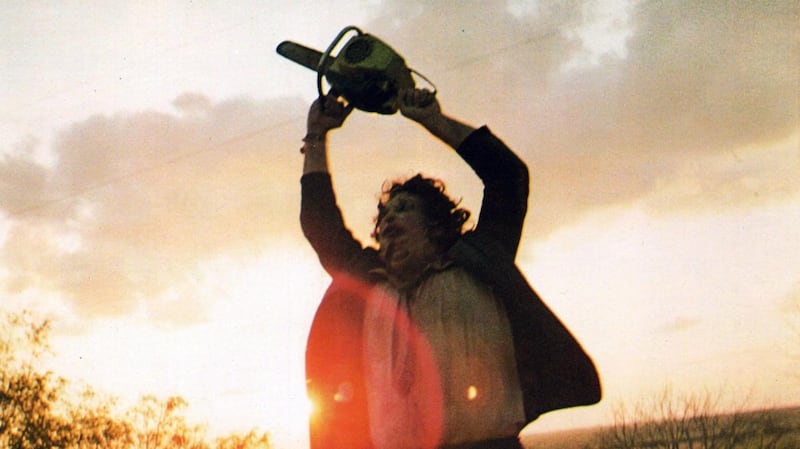’Tis the season to be terrified as the Irish-born, American-raised season of spooks and spectacle reaches its natural conclusion tomorrow night with teeth-rotting, liver-damaging bacchanalia. But in a world still traumatised by two years of death and pestilence, what’s behind the allure of a good scare?
"My motto is that a spoonful of horror makes the medicine go down," says Sarah Cleary, whose book The Myth of Harm explores how more than a century of horror has been condemned, controlled and censored in response to fear that it harms children.
“People associate horror with darkness, but I see it more as a lightbulb that illuminates anxieties we can’t articulate. Horror gives us a safe space to explore unsafe themes and experiences. It’s a release valve, as screaming is as good as laughing when it comes to relieving tension.”
"It's a psychological necessity," says Darryl Jones, professor of modern British literature and culture at TCD. "Moral panics often start from a place that somehow an appetite for horror will make you do the thing you have seen." But it has the exact opposite purpose. "It's the Aristotelian theory of catharsis. We watch a tragedy to expose ourselves to the spectacle of cruelty and terror, to purge ourselves of those emotions within us. It's a healthy thing to do."
Greek tragedy was basically highbrow horror. “These are works that set the bar very high for violence and gore,” says Jones. “The Bacchae ends with the dismemberment of the protagonist by his mother, who parades around with his decapitated head. Oedipus kills his father and tears out his own eyes. While Medea slaughters her own sons.
“These are images we are used to in extreme cinema. But they have been a part of human civilisation since the very beginning. Why? Because they provided audiences with an opportunity to reflect on their own social, political and religious values at a distance.”
It is this questioning that ensures that horror has continued to thrive with each passing generation. “Because it asks the same, existential questions that religion asks,” Jones says. “What is the social function of violence? What happens to us after death? Can we return from the dead or speak across the veil?”
Morality
“It teaches us morality,” says Cleary. “At its core, it’s about bad people doing bad things to good people and hopefully, by the end, the cosmic balance is restored. Though not always, as what horror is so good at is twisting the narrative to reveal the good in bad people and vice versa.”
Fairy tales were some of the earliest horror stories. “They played to our anxieties that we weren’t as good as we thought we were. They spoke about abuse within the home, of maternal disinterest, of being careful what we wished for, and of not judging a book by its cover.”
While the ancient Greeks used tragedy to explore their complicated relationships with the gods, the ancient Irish used otherworldly figures such as the Banshee to come to terms with concepts such as death, illness and disability. Most disturbing was the belief that children who had a disability or were ill or infirm had been swapped with an elderly or dying fairy or ‘changeling’. Many were abandoned or killed, with the myth serving as a way to assuage any guilt parents may have felt over their actions.
But nearly all of the most famous monsters have their roots in confusion and disturbance at natural biological occurrences. Vampires and werewolves emerged as a reaction to diseases such as rabies or porphyria, which caused itching, rashes and blisters to the sufferer every time their skin was exposed to sunlight. In extreme cases, their nose or ears fell off.
“We weren’t as educated or sophisticated then, so fables made things interesting enough for people to understand and remember the dangers of the world around them,” says Cleary. But it’s when the Romantic literary movement bled into the Gothic that we see the template from which most horror today takes its cue.
Graveyard poetry delivered gloomy meditations on mortality, with its imagery of skulls, coffins, epitaphs and decay. The scientist Giovanni Aldini captured the imaginations of the intelligentsia by reanimating the corpse of a criminal in front of a live audience, using electricity to contort his mouth and open his eyes, under the false assumption that the world’s most exciting new invention might be able to bring back the dead.
Out of all this sprang Mary Shelley’s Frankenstein in 1818. “Shelley was directly responding to the social anxieties of her day. She had lost two children during childbirth. Her husband’s ex had killed herself while pregnant. There was this growing obsession with the body, with flesh and what was underneath it. The study of anatomy had exploded and graveyards were pillaged to help sate this thirst for scientific knowledge.”
This all came to a head in 1859 with the publication of Charles Darwin’s On the Origin of Species. “The shock of its revelation, that humans were no longer the centre of creation but a subject of evolution, led to a Victorian crisis in faith,” says Jones. “People started to question whether the reverse was possible. Could we degenerate into lesser species? What would it feel like for your body to transform against your will? To not feel at home in your own skin?”
These new ideas shattered the existing order. Up to this point, religion had permeated every area of society, unquestioned. If we are just material things, what happens to the idea of an afterlife? The idea of death being totally final became too much to handle and there was a massive move towards spiritualism.
“A recommitment to a belief in the existence of life after death, of another world beyond our own, where spirits interact with us from beyond the grave. This led to a rise in mediums, seances and Ouija boards, which, in turn, contributes to the golden age of the ghost story,” says Jones.
Imperialism
As the British empire went into decline, Victorians were plagued by thoughts of reverse colonisation and karmic retribution. "It's easy to see how the mummies' curse can be interpreted as a reaction to the violence facilitated by imperial designs, a response to when you take things from their proper place in the world," says Eleanor Dobson, senior lecturer in 19th-century literature at the University of Birmingham.
"If one wanted a souvenir from Egypt, it was easier to take back a mummified hand, foot or head [than a whole mummy], so these parts were broken off from the rest of the body, which was then discarded." Mummies were unwound in private homes for personal entertainment and ground up to be used in medicine and paint.
Victorians fretted about the decline in morality towards the end of the 19th century, as the Jack the Ripper killings and the trial of Oscar Wilde dominated public conversation. "You see an emerging interest in eugenics and physiognomy, where facial features are believed to be representative of your moral character," says Cleary. Freak or monster shows were common, where people of unusually small or tall stature, bearded ladies, supposedly feral children and "hermaphrodites" were put on display in pubs, private clubs, fairs and museums.
Developments in technology allowed people to more explicitly indulge their darkest desires communally. “Grand Guignol was one of the first times we saw horror performed on the stage, with its gory, realistic special effects making the depictions of dismemberment more graphic than ever.” People variously fainted, threw up and became aroused.

Early cinema flourished specifically because of the horror genre. "Horror has always attracted a transgressive audience," says Peter Dunne, creator of the children's horror podcast Spooky FM. "It started with American TV in the 1950s when TV stations would play low-budget movies at midnight, introduced by people like Vampira."
By the 1970s cinema had got involved, with younger crowds heading to dingy cinemas late at night to watch movies such as Freaks, Eraserhead, The Night of the Living Dead and Cannibal Holocaust. “It was a rite of passage, a statement against the mainstream. You weren’t watching your parents’ movies. But you were also part of a community of cinemagoers. And I think that sense of community is important when it comes to horror.”
The emergence of video killed off the midnight movies in the 1980s but, as always, horror adapted, giving rise to the video nasties. “There was just a wave of movies that weren’t going past the censor, that had no age rating, and with so much competition, the makers needed to capture the renters’ imagination fast, which they did with lurid titles like Driller Killer, Cannibals in the Streets, I Spit On Your Grave, with equally gory covers.”
By 1984 the public had had a moral panic, and many of these movies were banned. It only increased the allure. “It became a holy grail, that added fear, those shady trips to the video store, buying things under the counter, rumours spreading about where you could get certain titles, while cousins smuggled home copies of A Clockwork Orange or The Exorcist from holidays abroad. The whole process really added to the experience of watching the movie, many of which were rubbish,” says Dunne.
"I miss it. So much horror feels sanitised now when all you have to do is hop on Google to find something."
Contemporary concerns
Horror is the ultimate vessel to attach the concerns of the day. “And that’s the reason so many of its greatest monsters continue to be revived,” says Cleary. “Because each new generation transfuses them with their own concerns, making them live anew.”
And new monsters emerge all the time. In the 1950s Godzilla was a clear reaction to the trauma of nuclear weapons. In the 1970s The Last House on the Left and The Texas Chain Saw Massacre brought the horrors of American imperialism home. Directors David Cronenberg and John Carpenter explored the Aids crisis in the 1980s through body horrors such as The Fly and The Thing. While, more recently, internet forums such as CreepyPasta have birthed viral horrors, such as Slender Man and Momo, that have captured the wider public imagination more effectively than most cinematic contributions.
"Horror might be disturbing, but it is not disturbed," says Cleary. "Even now people are using TikTok and Zoom and YouTube to exorcise their anxieties about where we are going. No other genre lets us manifest the fears we don't want to think about or speak about or even acknowledge and do it in a way where we are not being lectured or spoken down to and that is entertaining."





















